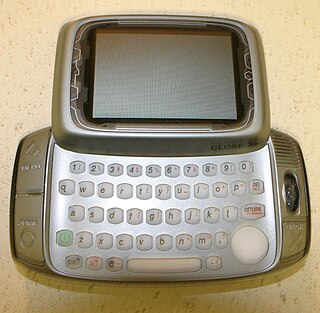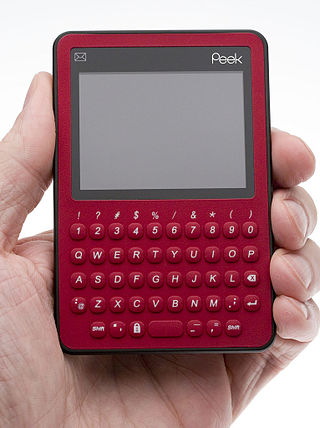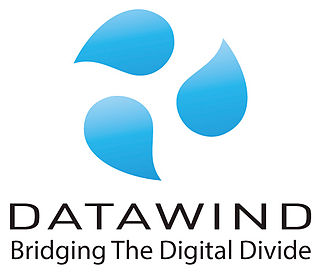
In telecommunications, an acoustic coupler is an interface device for coupling electrical signals by acoustical means—usually into and out of a telephone.

A Pocket PC is a class of personal digital assistant (PDA) that runs the Windows Mobile or Windows Embedded Compact operating system that has some of the abilities of modern desktop PCs. The name was introduced by Microsoft in 2000 as a rebranding of the Palm-size PC category. Some of these devices also had integrated phone and data capabilities, which were called Pocket PC Phone Edition. Windows "Smartphone" is another Windows CE based platform for non-touch flip phones or dumber phones.
A voicemail system is a computer-based system that allows people to leave a recorded message when the recipient is unable to answer the phone. The caller is prompted to leave a message and the recipient can retrieve said message at a later time.

The Danger Hiptop, also re-branded as the T-Mobile Sidekick, Mobiflip and Sharp Jump, is a GPRS/EDGE/UMTS smartphone that was produced by Danger, Inc. from 2002 to 2010.

The history of mobile phones covers mobile communication devices that connect wirelessly to the public switched telephone network.

Windows Mobile is a discontinued mobile operating system developed by Microsoft for smartphones and personal digital assistants.
In information technology, a notification system is a combination of software and hardware that provides a means of delivering a message to a set of recipients. It commonly shows activity related to an account. Such systems constitute an important aspect of modern Web applications.
Push email is an email system that provides an always-on capability, in which when new email arrives at the mail delivery agent (MDA), it is immediately, actively transferred (pushed) by the MDA to the mail user agent (MUA), also called the email client, so that the end-user can see incoming email immediately. This is in contrast with systems that check for new incoming mail every so often, on a schedule. Email clients include smartphones and, less strictly, IMAP personal computer mail applications.
Internet fax, e-fax, or online fax is the use of the internet and internet protocols to send a fax (facsimile), rather than using a standard telephone connection and a fax machine. A distinguishing feature of Internet fax, compared to other Internet communications such as email, is the ability to exchange fax messages with traditional telephone-based fax machines.

Google Voice is a telephone service that provides a U.S. phone number to Google Account customers in the U.S. and Google Workspace customers in Canada, Denmark, France, the Netherlands, Portugal, Spain, Sweden, Switzerland, the United Kingdom and the contiguous United States. It is used for call forwarding and voicemail services, voice and text messaging, as well as U.S. and international calls. Calls are forwarded to the phone number that each user must configure in the account web portal. Users can answer and receive calls on any of the phones configured to ring in the web portal. While answering a call, the user can switch between the configured phones. Subscribers in the United States can make outgoing calls to domestic and international destinations. The service is configured and maintained by users in a web-based application, similar in style to Google's email service Gmail, or Android and iOS applications on smartphones or tablets.
NASA spin-off technologies are commercial products and services which have been developed with the help of NASA, through research and development contracts, such as Small Business Innovation Research (SBIR) or STTR awards, licensing of NASA patents, use of NASA facilities, technical assistance from NASA personnel, or data from NASA research. Information on new NASA technology that may be useful to industry is available in periodical and website form in "NASA Tech Briefs", while successful examples of commercialization are reported annually in the NASA publication Spinoffs. The publication has documented more than 2,000 technologies over time.
Mobile translation is any electronic device or software application that provides audio translation. The concept includes any handheld electronic device that is specifically designed for audio translation. It also includes any machine translation service or software application for hand-held devices, including mobile telephones, Pocket PCs, and PDAs. Mobile translation provides hand-held device users with the advantage of instantaneous and non-mediated translation from one human language to another, usually against a service fee that is, nevertheless, significantly smaller than a human translator charges.

A modulator-demodulator or modem is a computer hardware device that converts data from a digital format into a format suitable for an analog transmission medium such as telephone or radio. A modem transmits data by modulating one or more carrier wave signals to encode digital information, while the receiver demodulates the signal to recreate the original digital information. The goal is to produce a signal that can be transmitted easily and decoded reliably. Modems can be used with almost any means of transmitting analog signals, from light-emitting diodes to radio.

A feature phone is a type or class of mobile phone that retains the form factor of earlier generations of mobile telephones, typically with press-button based inputs and a small non-touch display. They tend to use an embedded operating system with a small and simple graphical user interface, unlike large and complex mobile operating systems such as Android from Google or iOS from Apple.

Mobile technology is the technology used for cellular communication. Mobile technology has evolved rapidly over the past few years. Since the start of this millennium, a standard mobile device has gone from being no more than a simple two-way pager to being a mobile phone, GPS navigation device, an embedded web browser and instant messaging client, and a handheld gaming console. Many experts believe that the future of computer technology rests in mobile computing with wireless networking. Mobile computing by way of tablet computers is becoming more popular. Tablets are available on the 3G and 4G networks.
Exchange ActiveSync is a proprietary protocol designed for the synchronization of email, contacts, calendar, tasks, and notes from a messaging server to a smartphone or other mobile devices. The protocol also provides mobile device management and policy controls. The protocol is based on XML. The mobile device communicates over HTTP or HTTPS.

Peek Inc. was an technological mobile company which was founded in 2007 and then got headquartered in New York City, from 2008 to 2012. It had offered a series of mobile handheld devices which gave access to email and various social networks.

Jeotex, Inc. was a Canadian company that developed and manufactured low-cost tablet computers and smartphones. Founded in Montreal, Quebec, the company aimed to produce tablets primarily for markets in India, Nigeria, the United Kingdom, Canada, and the United States. Joetex created the Aakash tablet computer, which was called the "world's cheapest tablet" as it was priced at US$37.99 per unit in 2012. The Aakash was developed for India's Ministry for Human Resource Development (MHRD).
Microsoft mobile services are a set of proprietary mobile services created specifically for mobile devices; they are typically offered through mobile applications and mobile browser for Windows Phone platforms, BREW, and Java. Microsoft's mobile services are typically connected with a Microsoft account and often come preinstalled on Microsoft's own mobile operating systems while they are offered via various means for other platforms. Microsoft started to develop for mobile computing platforms with the launch of Windows CE in 1996 and later added Microsoft's Pocket Office suite to their Handheld PC line of PDAs in April 2000. From December 2014 to June 2015, Microsoft made a number of corporate acquisitions, buying several of the top applications listed in Google Play and the App Store including Acompli, Sunrise Calendar, Datazen, Wunderlist, Echo Notification Lockscreen, and MileIQ.
Nokia Mail and Nokia Chat were services developed by Microsoft Mobile and earlier by Nokia for its mobile phones. The service operated as a centralized, hosted service that acted as a proxy between the Messaging client and the user's e-mail server. The phone did not connect directly to the e-mail server, but instead sent e-mail credentials to Nokia's servers. On 13 August 2008 Nokia launched a beta release of "Nokia Email service", a push e-mail service, later incorporated into Nokia Messaging. The original version of Nokia Messaging was launched in 2008 with the Nokia N97 line of smartphones and was exclusive to Finland, the United Kingdom, the Netherlands, Germany, Spain, Singapore, Australia and Venezuela before being expanded to other countries and was exclusive to Symbian handsets, Series 40 support was announced for 2009. The first public version of Nokia Messaging supports Windows Live Hotmail accounts, Yahoo! accounts, and Google accounts and was available in 12 languages.








